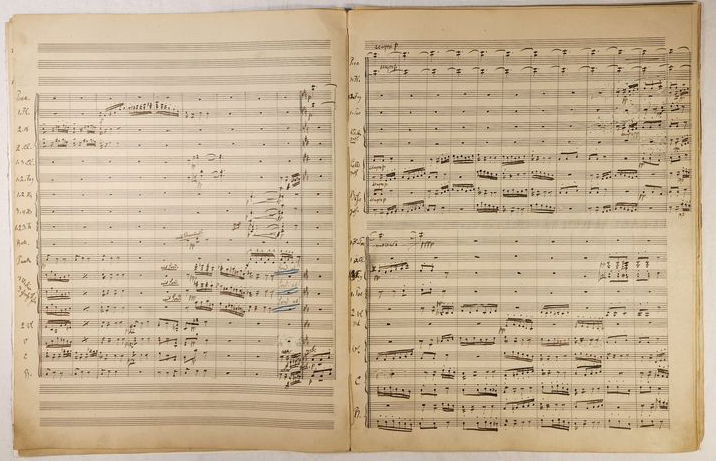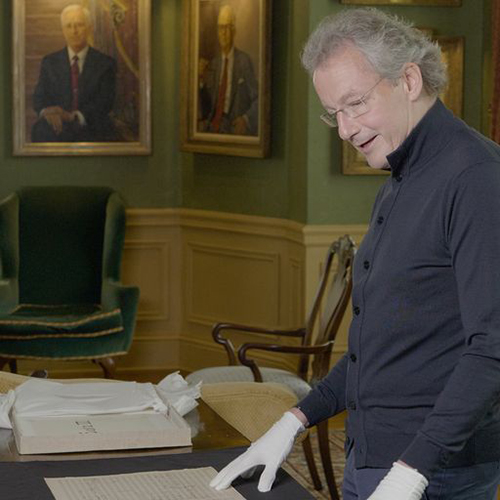by Daniel Hathaway

. The Cleveland Orchestra receives autograph manuscript of Mahler 2
. Two American musical scholars and three contemporary composers share birthdays
NEWS:
On Tuesday, André Gremillet, President and CEO of The Cleveland Orchestra and Music Director Franz Welser-Möst, announced in a press release, the historic gift to the Orchestra of the autograph manuscript of Gustav Mahler’s Symphony No. 2, “Resurrection,” generously donated by one of its Trustees, the noted Austrian media executive and philanthropist Herbert G. Kloiber.
Written in the composer’s own hand in 1894, the 232-page, unaltered document is the only complete autograph manuscript of the complete symphony in existence, and it contains the invaluable marks of Mahler’s alterations and annotations. Long recognized for its affinity with the Austro-German repertoire, The Cleveland Orchestra will preserve the manuscript in partnership with the Cleveland Museum of Art, making it available to scholars, and accessible for public viewing in the future.

The manuscript was purchased anonymously at auction at Sotheby’s in 2016. Dr. Kloiber — an international trustee of The Cleveland Orchestra and chair of its European Advisory Board, as well as an advisory director of the Metropolitan Opera— has now been publicly identified for the first time as the previous owner of the autograph manuscript prior to generously donating it to The Cleveland Orchestra.
Herbert G. Kloiber said, “When I acquired the Mahler autograph score, I knew I was doing so only as a temporary caretaker, responsible for finding a permanent home for this magnificent document. My experiences with The Cleveland Orchestra in recent years, both on tour in Europe and in its wonderful concert hall at Severance Music Center, moved me to conclude that it would provide a wonderful home for this great document to reside.”
The document’s provenance can be traced directly to Mahler’s widow Alma, who gave the manuscript to the Dutch conductor Willem Mengelberg. After Mengelberg’s death, the Mengelberg Foundation retained ownership and it was eventually put on deposit at the Gemeentemuseum in the Hague in 1982. In 1984, the American financial publisher Gilbert Kaplan purchased the score. Following Kaplan’s death in 2016, the manuscript was put up for auction at Sotheby’s, where Herbert G. Kloiber purchased it anonymously.
In December 1910, Mahler made his only trip to Cleveland during his lifetime to conduct a concert of the New York Philharmonic at Grays Armory. The founder of The Cleveland Orchestra, Adella Prentiss Hughes, arranged that Cleveland be the first stop for the Philharmonic on its inaugural tour west from New York City.
Photos: Roger Mastroianni courtesy of The Cleveland Orchestra. This story also appears in today’s in an article by David Allen in the print edition of the New York Times.
TODAY’S ALMANAC:
Two American musical scholars and three contemporary composers share birthdates on September 28.
Donald J. Grout, born in 1902 in Rock Rapids, Iowa, and H. Wiley Hitchcock, who wrote the first entry in his own bio in 1923 in Detroit, left indelible marks on classical music as author and editor, respectively, of A History of Western Music (known to generations of students simply as “Grout”), and The New Grove Dictionary of American Music.
American composers Vivian Fine and Laura Kaminsky came onto the scene in 1913 in Chicago, and 1956 in New York City, and Chinese-American composer Huang Ruo followed in 1976 on Hainan Island off the southern coast of China.
Kaminsky was featured by Jarrett Hoffman in the Diary in 2020, so we’ll zoom in on the other two composers this time around.
Fine was a protégé of Ruth Crawford, who introduced the young composer to Henry Cowell and his circle. She later became a member of Aaron Copland’s Young Composers Group, and helped found the American Composers Alliance. She became one of New York’s go-to performers of contemporary piano music in the 1930s. Fine later joined the faculty of Bennington College in Vermont, where she died at the age of 86 from injuries sustained in a motor accident.
As a composer, Vivian Fine seemed to bring a unique style to each of her works, many of which conveyed a sense of humor and fun. For just two examples, click here to hear her Missa Brevis per quattro violoncelli e voce registrata (1972) performed by mezzo-soprano Jan DeGaetani with cellists Eric Barlett, David Finckel, Michael Finckel and Maxine Neuman, and here to listen to her Songs and Arias (1992), performed by the Luna Nova Ensemble (Robert Patterson, horn, Gregory Maytan, violin, and Craig Hultgren, cello).
After entering the Shanghai Conservatory at the age of 12, Huang Ruo studied at the Oberlin Conservatory (as did Laura Kaminsky) and at Juilliard. He was one of the original founders of the International Contemporary Ensemble (ICE).
Click here to watch violinist Jennifer Koh play his A Dust in Time (Passacaglia for Solo Violin), and here to watch Wu Wei and Friederike Richter perform his Wind Blows in a version for sheng and piano. There’s also a version for oboe and orchestra, performed here by García-Cano with Muhai Tang and the Beijing Symphony.


